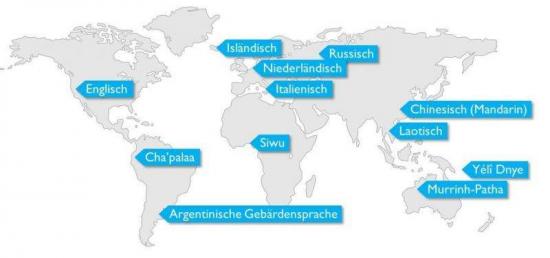Max Planck Society
Source - http://phys.org/news/2015-09-universal-patterns-human.html
 For their study, the linguists chose twelve languages with very different phonetics and grammar. Their analysis of everyday conversations showed that people use the same underlying basic patterns to resolve misunderstandings. Credit: MPI for Psycholinguistics
For their study, the linguists chose twelve languages with very different phonetics and grammar. Their analysis of everyday conversations showed that people use the same underlying basic patterns to resolve misunderstandings. Credit: MPI for Psycholinguistics
When people talk to each other, there are plenty of opportunities for communication problems to occur. Sometimes we don't hear individual words correctly, at other times, contexts are not clear. Or we are unsure if we have understood the essential message. A team of scientists from the Max Planck Institute for Psycholinguistics in Nijmegen has now discovered mechanisms that people worldwide use to clarify confusion in conversation, thereby 'repairing' communication.
On average, people resolve misunderstandings in communication once every 90 seconds. The new research finding, published in the open-access journal PLOS ONE, suggest that this principle applies universally - across languages. "Without such a system, our communication would fail constantly," says Mark Dingemanse, first author of the study.
An international team of linguists, headed by Dingemanse and Nick Enfield (now at the University of Sydney) analyzed video recordings of conversations in twelve different languages from five continents. The languages ranged from English, Russian and Mandarin to Cha'paa in Ecuador, Siwu in Ghana to Argentinean sign language. All these languages differ fundamentally from each other in phonetics and grammar. The comparison showed that the same basic system is used for linguistic ambiguities and their repair. In principle, this system consists of people halting proceedings to ask for clarification of what was just said.
Three strategies to resolve misunderstandings
Overall, the researchers identified three underlying "repair" strategies that are applied regularly. The first, "open question", is often expressed by a simple "huh?" expression. It signals a fundamental problem in understand and requires the greatest clarification effort: a complete repetition of what was said. In the second strategy, concrete questions such as "Who?" and "Where?" are used to clarify certain pieces of information or discover more details. The third option is for the listener to repeat what was just said or to repeat in their own words, and asking for confirmation. The last strategy requires the least amount of clarification effort, at best, a simple "yes".
It is also striking that most people use this "repair" system in an altruistic way, preferring to select a strategy that minimizes the effort required by the speaker to resolve the disruption. Listeners are more likely to ask concrete questions than using the simple form "huh?" This reveals the deeply social nature of human language use.
Only humans monitor states of understanding
The findings shed light on what is special about human language: Other species have also developed complex communication, but none is known to halt the communication sequence and initiate repair. Because only human language is able to communicate about itself. Humans are also special in that they monitor the success of mutual understanding. "We are masters of the kind of cooperation that is required to for communicative repair," Nick Enfield summarizes a fundamental insight of the research.
The scientists hope that their findings will contribute to making computers behave more "human" in the future if they fail to understand spoken instructions. The research team believes that other possible applications for their study could be in teaching or intercultural cooperation.
More information: "Universal Principles in the Repair of Communication Problems." PLoS ONE 10(9): e0136100. DOI: 10.1371/journal.pone.0136100